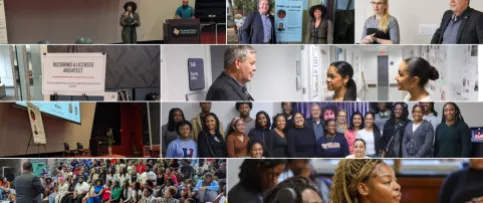In June, Nevada architect Gregory L. Erny, FAIA, NCARB, was installed as NCARB’s FY18 president. In this role, he will lead the organization that supports the 54 U.S. architectural licensing boards, which serve more than 111,000 licensure candidates and architects.
We caught up with President Erny to discuss his vision for the coming years at NCARB, his motivation for giving back to the profession, and his advice for the next generation of architects.
Why did you decide to pursue architecture?
My dad was involved in the construction industry. I wound up getting a lot of exposure to the construction side of the building industry on the weekends, and that's what initially got my attention.
Architecture is about problem-solving; it has both artistic and technical aspects. My practice has gravitated toward renovation projects, which always have challenges and limitations. You’re working in the context of something that's already there, trying to modernize a facility with outdated functionality, accommodating an entirely new use and purpose. Solving the problems that arise when you’re adapting a building that was designed and constructed with a different set of parameters in mind has always appealed to me.
Why was earning a license important to you?
For me, earning a license was always a given. I may have had an architectural education, but I wasn't an architect until I got licensed. I also always wanted to have my own practice. Licensure gives the public an assurance that the person who is performing the work is capable and qualified to design the places where we live and work. Having that sense of comfort is something we all take for granted—when you walk into a place with a roof, you're going to walk out without any concerns that the roof will collapse while you are inside.
How did you first get involved with NCARB?
My involvement in NCARB started by becoming a member of a local state board. Once I got on the state board, I was encouraged to get involved with the Architect Registration Examination® (ARE®) committees, and I volunteered to be on a pre-design committee writing test questions. It was an eye-opening experience to learn how all the questions that show up on the exam get developed. There is a great deal of time and energy that goes into what you would think is a pretty simple process.
What advice do you have for today’s licensure candidates?
My advice is to get a license. It not only puts an invaluable and universally accepted tool in your belt, but also puts a respected credential on your resume that you can carry with you for the rest of your life—even if you don’t always use it. Having flexibility in your options and your capabilities is a key part of having opportunities later in your career.
Tell us about some of the initiatives you’ll be focusing on over the next year.
There are several things I’d like to focus on. As much as we have done over the last few years and the advancement of the new exam, there are more improvements to be made on the experience component of licensure—especially the supervisors and mentors aspect. More interest and support from supervisors—and a better relationship between supervisors and candidates—is key to helping connect education to experience and motivating candidates to achieve licensure. I’d also like to build up the Integrated Path to Architectural Licensure (IPAL) initiative so more students can connect education, experience, and examination.
I also think we need to respond to the changes that are happening exponentially within our profession. That’s why I’m creating a Futures Task Force, so we’re able to identify where the profession may be going and prepare our future practitioners to be professionally qualified and properly credentialed to handle the challenges they may face.
Why do you think supervisors are such an important part of the profession?
The role of the supervisor and mentor is vital because not everything can be learned in the context of an educational environment. The experience component complements that education, and together they ultimately prepare you to take the exam and become a practicing architect.
Architecture is constantly evolving, so it’s vital that supervisors and mentors are able to recognize things that a student coming out of an educational institution may need to enhance or supplement through experience, in addition to meeting just the fundamental experience requirements of the licensure process. The role of the supervisor and mentor needs to be one of inspiration and encouragement as well—someone who is willing to give their knowledge and wisdom back to the licensure candidate so they can grow into a licensed practitioner.


